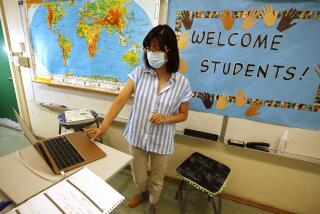Tragedy’s Lessons Go to School
- Share via
Seventeen years ago, fifth-grader Jennifer Kramer -- then an aspiring astronaut -- turned to her teacher for answers when her class watched in stunned horror as the space shuttle Challenger exploded, killing all seven crew members. What she learned only stoked her passion for science.
On Monday, Kramer -- now a middle-school teacher -- came to school wearing a blue NASA jacket and armed with newspapers, photographs and poems to help her seventh-graders understand both the majesty of the space shuttle Columbia’s mission and the tragedy of its midair disintegration.
For Kramer and countless other teachers, Saturday’s deadly Columbia disaster provided a valuable “teachable moment,” an opportunity to use a real-life event to deliver unforgettable lessons in science, math, social studies and even life.
“It’s chilling, but it’s what made me want to be a teacher,” said Kramer, who is in her third year at Lawrence Middle School in Chatsworth. “This is a chance to make it count for something ... the stuff that makes teachers glad they went into teaching. It’s what can make kids realize that life is happening all around them.”
For many youngsters, the loss of the Columbia lacked the drama of the Challenger -- which carried a schoolteacher on board and vaporized on live television -- or the tragic implications of the terrorist attacks on the World Trade Center.
“This was not even close,” said Brent Smiley, a history teacher at Lawrence. Those earlier tragedies left teachers battling their own emotions, while they struggled to interpret for stunned students the emerging images.
This time, although campus flags flew at half-staff and many schools observed a moment of silence, there was little of the grief and bewilderment that had gripped schools during the earlier ordeals. There were no school district edicts or mental health tips. Some teachers made no mention of the Columbia’s tragedy; those who did had taken the time to cull lessons from it.
This time, they were not required to soothe frightened children, but to help their students understand why the adults around them seemed so unnerved.
“Remember, these are kids who experienced 9/11,” said Smiley. “It takes a lot to measure up. They don’t understand what all this means: ‘Seven people died. People die every day. What’s the big deal about that?’ ”
Young people today are growing up with space exploration in the background of a world so full of high-tech marvels that the miraculous can seem mundane.
The shuttle’s disintegration in the stratosphere might seem no more extraordinary to them than an airplane plunging to the ground or a crash between a car and a train. Many realized this was big news only because it prompted a marathon news blitz that kept their favorite TV shows off the air.
For some kids, the only time they are sure to hear about space shuttle missions is when a tragedy occurs.
As Kramer took questions from her seventh-graders, she was surprised to hear one boy ask, “Have we ever gotten anybody back alive?”
They know so little about space travel “their perception is that we have only flown twice, and both times have been disasters,” she said.
But sometimes, disaster can provide a fertile ground for teachers.
On Monday, Kramer used her science background -- for eight years she’s worked with NASA training teachers at a summer space camp in Alabama -- to sprinkle her lesson on the Columbia disaster with facts that drew links between what her students know and what they can only imagine.
The shuttle was experiencing 3,000-degree heat as it roared back toward earth, she told them. “You guys complain about taking P.E. when the temperature is 103. Think about that. Three-thousand degrees.” The children groaned.
At the shuttle’s speed of 13,000 mph, it could get from Florida to California in 20 minutes. “That trip would take us 6 1/2 hours by plane.”
In a single day in outer space, astronauts looking down on Earth could see the sun rise and set 16 times.
She left them pondering the absurd and the unbearable. How could a piece of foam insulation precipitate such a disaster, if indeed that was the cause? What about the 12 children the seven dead astronauts left behind?
And she reminded them that life goes on, that just as she once watched her parents celebrate the quest to reach the moon, “one day your kids will be able to say, ‘We’re going to Mars.’ That’ll be your adventure, putting life on Mars.”
“Whoa,” many kids said. Others giggled. In some classes, the students didn’t have much to say. When one math teacher asked if anyone had questions, no one raised a hand. He put away the photographs he’d prepared to show them.
For Smiley, the social studies teacher, the loss of Columbia was a chance to put tragedy in historical perspective.
“On one hand it’s really sad that they died,” he told his seventh-graders. “But they knew the risks going in and made a conscious decision to go forward. Will there be more accidents in space? Yes. Will more people die? Absolutely.
“But as long as there are people who are willing to dream, there will be no shortage of astronauts; people who are willing to go up there to take humanity one more step forward.”
More to Read
Sign up for Essential California
The most important California stories and recommendations in your inbox every morning.
You may occasionally receive promotional content from the Los Angeles Times.













